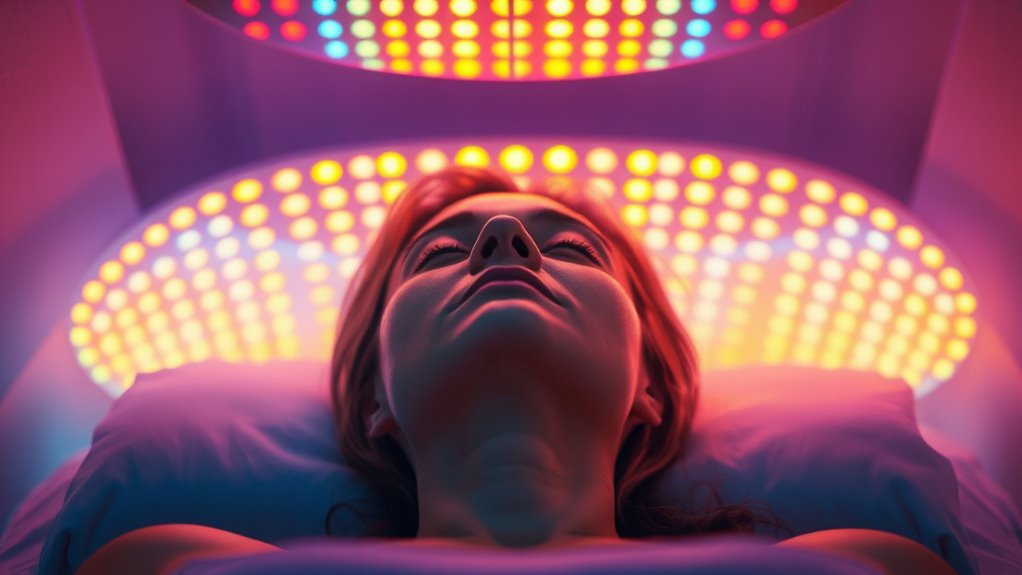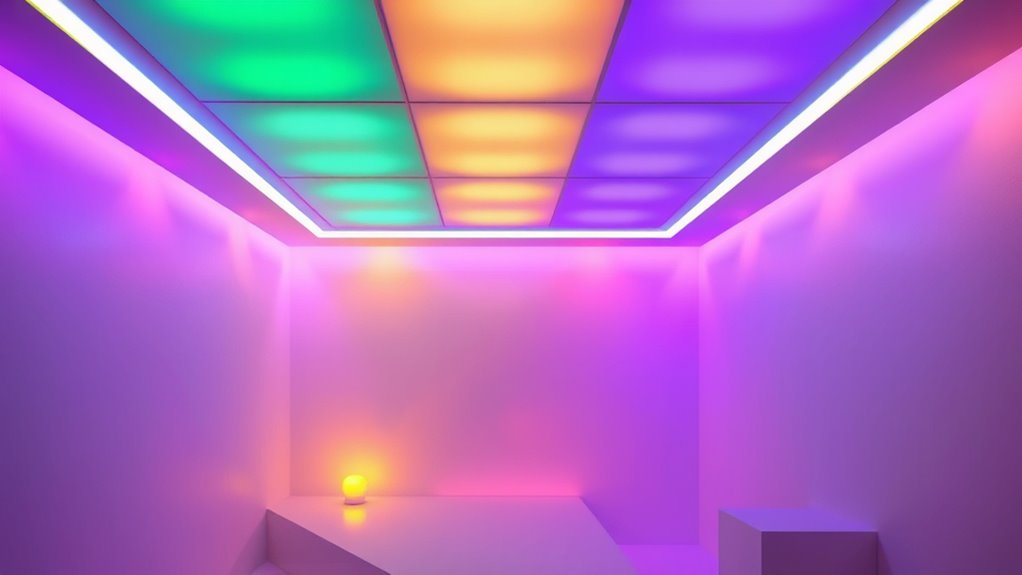Chromotherapy, also called color therapy, uses the power of light and colors to boost your physical and emotional health. By exposing yourself to specific hues through lights or filters, you can influence your mood, reduce stress, and restore balance in your body. Colors carry energetic qualities that your brain interprets, guiding your healing process. If you want to discover how this natural method can impact your well-being, explore how light and color might work for you.
Key Takeaways
- Chromotherapy uses targeted colors and light to promote physical and emotional healing through visual perception.
- It influences mood, physiological functions, and energy balance by exposing individuals to specific hues.
- Light therapy in chromotherapy involves colored lights, filters, or lamps to deliver healing wavelengths.
- Personal color choices are tailored to individual needs like relaxation, clarity, or vitality.
- As a complementary approach, chromotherapy supports overall well-being and harmony within the body.

Chromotherapy, also known as color therapy, is a holistic healing method that uses the power of colors to promote physical and emotional well-being. At its core, this approach harnesses your natural ability for color perception—your brain’s interpretation of different wavelengths of light. When you’re exposed to specific colors, your body responds in ways that can help balance energy, reduce stress, and support healing. Light therapy plays a pivotal role here by delivering targeted hues that influence your mood and physiological functions. By understanding how your eyes perceive light, you can tap into this natural process to enhance your health.
Colors aren’t just visual stimuli; they carry energetic qualities that your mind and body can absorb. For instance, when you focus on calming blue, you may notice a sense of tranquility washing over you. Conversely, vibrant red can energize your body and boost circulation. This interaction hinges on your ability to perceive and interpret these colors accurately. Your brain processes light signals through your eyes, translating them into emotional and physical responses. Light therapy in chromotherapy involves exposing yourself to specific wavelengths, often through visual aids like colored lights, lamps, or filters, to stimulate these responses intentionally. This targeted exposure can help alleviate symptoms of anxiety, depression, or fatigue by encouraging your body’s natural balance.
The practical aspect of light therapy in chromotherapy is straightforward but powerful. You might sit in a room bathed in a particular color or use specialized devices that emit therapeutic hues. As you do so, your perception of the colors influences your subconscious mind, fostering a calming or invigorating effect. The key is selecting the right color for your needs—whether you seek relaxation, mental clarity, or emotional stability. Your ability to perceive and respond to these colors is essential because it determines how effectively the therapy works. When your eyes and brain are receptive, your body can better integrate the healing vibrations of each hue, making the process more effective.
Ultimately, chromotherapy leverages your natural light perception and the principles of light therapy to promote harmony within your body. By consciously choosing colors that resonate with your emotional or physical needs, you create a personalized healing experience. This method demonstrates how simple, natural elements—light and color—can have profound effects on your overall well-being. With awareness of how your perception influences your response, you can harness chromotherapy as a complementary approach to your health routine, supporting balance and vitality through the power of light.
Frequently Asked Questions
Can Chromotherapy Replace Conventional Medical Treatments?
No, chromotherapy can’t replace conventional medical treatments. It’s considered an alternative therapy that works best as part of a holistic approach to health. While it may support your overall well-being and complement traditional care, you shouldn’t rely on it solely for serious conditions. Always consult your healthcare provider before adding chromotherapy to your treatment plan, ensuring you get thorough and safe medical care.
Are There Any Side Effects From Chromotherapy Sessions?
Sure, you might experience some light sensitivity or skin reactions during chromotherapy, but don’t worry—those are just your body’s way of saying it’s not a fan of all that colorful excitement. While serious side effects are rare, you should stay alert for any discomfort or unusual skin reactions. If anything feels off, it’s best to stop and consult a professional, because even light therapy can have its quirks.
How Long Does a Typical Chromotherapy Treatment Last?
A typical chromotherapy treatment lasts about 20 to 30 minutes, depending on your specific needs. You usually undergo sessions once or twice a week, but this can vary based on your treatment plan. During each session, the light and color are carefully applied to target your issues. The treatment duration and session frequency are personalized to help you achieve the best possible healing results efficiently.
Is Chromotherapy Suitable for Children and Pregnant Women?
Yes, chromotherapy can be suitable for children and pregnant women, but you should prioritize pediatric safety and pregnancy considerations. Always consult a healthcare professional before starting treatment, as certain colors or light intensities may not be advisable during pregnancy. For children, ensure the practitioner is experienced with pediatric safety. Tailoring the approach ensures safe, effective therapy that supports their health without risks.
What Qualifications Should a Professional Chromotherapist Have?
You should look for a professional chromotherapist with proper training and certification standards. Confirm they have completed accredited programs that cover color theory, light therapy techniques, and safety protocols. Certification from recognized organizations demonstrates their expertise and commitment to ethical practices. This guarantees you’re in capable hands, receiving safe and effective treatment tailored to your needs. Always verify their credentials before starting therapy sessions.
Conclusion
So, next time you’re feeling off, just grab a rainbow and bask in its glow. Who knew that a splash of blue could soothe your nerves or a dash of red might energize your day? Forget pills or therapy—just turn on the color wheel and let the hues do the heavy lifting. After all, why not let Mother Nature’s paintbrush fix your problems while you sit back and enjoy the kaleidoscope?









